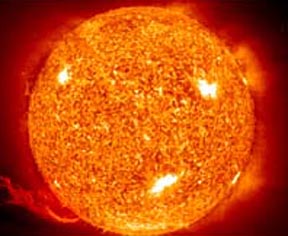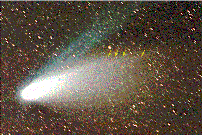Click on image for full size
Courtesy of NASA
Related links:
SOHO Catches Glimpse of the Sun's "Far Side"
News story originally written on June 23, 1999
The Solar and Heliospheric Observatory (SOHO) caught a rare view of the far side of the Sun. If solar activity is found by the satellite before that side of the Sun faces Earth, then scientists can forecast solar storms. This may save the satellite industry millions of dollars each year.
When the Sun releases large amounts of energy, the ultraviolet light makes patches of hydrogen gas glow. This glow is invisible to Earth, but not to SOHO. A special instrument called the Solar Wind Anisotropies (SWAN) was used to find these patches. This new technology can give scientists a few days warning before the storm actually hits.
"Strong ultraviolet emissions from active regions on the back of the sun behave like beams from a lighthouse on the landscape," says Jean-Loup Bertaux, of the CNRS Service d'Aéronomie in France, and principal investigator for SWAN. "They move in the sky in accordance with the sun's rotation," which takes about 28 days. "We can monitor the activity on the back side of the sun without looking at it directly. This method could be used in future studies on space weather, which can seriously affect orbiting satellites and other technological systems on Earth."
SOHO also captured the largest shadow ever seen. When Comet Hale-Bopp passed by in 1997, SOHO took a few photographs. Behind the comet, was a shadow over 150 million kilometers long. When the comet came near the Sun, it developed an enormous tail made of hydrogen. This tail and the comet itself were projected onto the sky.
"This phenomenon provides an absolute determination of the
amount of hydrogen and water released by the comet - about 300
tonnes per second" , says Bertaux.















